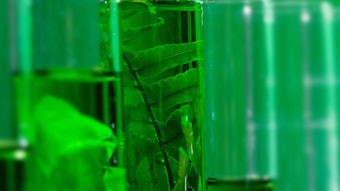“The important thing in science is not so much to obtain new facts as to discover new ways of thinking about them.”
—Sir William Lawrence Bragg
So many of today’s beauty consumers are driven by what they don’t want in their beauty products—parabens, phthalates, sulfates, fragrances—and “chemicals.” Seemingly, to this growing number of chemical-averse consumers, only lotion hand-made on Aunt Ethyl’s Yak Farm will do. But while these consumers may avoid materials on the perceived “bad” list, their products must still have ingredients that are functional, economical and resonate with a natural aura. To satisfy these needs, amino acid-based products are a wonderful choice for both consumers and product developers.
Creating Products
Amino acids have an amino group (-NH2) and a carboxyl group (-COOH) resulting in the basic structure shown in Figure 1. Amino acids can be combined into polymers, some of which are the proteins so essential to life. There are 23 different amino acids used to make proteins, and because amino acids in the form of proteins are the fundamental building blocks of skin and hair, it is logical skin and hair will have a special affinity for beauty ingredients incorporating these amino acids—and that these ingredients will have a high degree of mildness and safety.
Starting from a single molecule, amino acids can be combined into larger structures that have been given unique names based on size. Combining them into a very small polymer creates a peptide. Sometimes this is further refined into dipeptides (two amino acids) and tripeptides (three amino acids). Oligopeptides are chains up to 20 amino acids, and polypeptides are chains up to 50 amino acids. Longer chains, above 100 amino acid units, are proteins.
Amino acids are sometimes used individually as single molecules. Examples are the popular skin care ingredients proline, glycine, leucine and lysine. Peptides can be described by their sequence of amino acids, such as PQEK (proline-glutamine-glutamate-lysine). With an extra technical tweak, we can arrive at palmitoyl pentapeptide (Sederma’s Matrixyl), a much-used peptide mix of Pal-GHK and Pal-GQPR where the amino acids are linked to a palmitic chain for enhanced effectiveness of delivery.
There are two broad approaches to developing novel amino acid-based ingredients—one is to incorporate an amino acid into a molecule as a component, and another is to create a complete product through biosynthesis. An example of incorporation is to use glycine in the sulfate-free surfactant sodium cocoyl glycinate. It is important to also derive the cocoyl chain from nonpetroleum renewable sources so the resulting molecule is as green and natural as possible.
Just making a sulfate-free material using amino acids does not automatically make it acceptable for beauty and personal care applications, however. Cost and performance are also key factors.
Though consumers demand green and natural, they are reluctant to pay more. Furthermore, they expect the performance of novel products to match or exceed that achieved from conventional chemistry. Fortunately, that can be true for amino acid-based surfactants. The cost has become very competitive, they foam very well and they leave a great after-feel.
These surfactants can perform a variety of uses. In a shampoo or body wash, they can be the primary surfactant, or as co-surfactant, they can reduce irritancy and improve sensory attributes. They also can be used to form the basis of a clear or opaque bar soap. Sodium lauroyl sarcosinate, for example, can be used in applications as diverse as mouthwash and hard surface cleaners.
Materials and Uses
The range of functional amino acid-based raw materials has expanded far beyond surfactants. Emulsifiers, moisturizers, emollients, thickeners and preservatives have been made and marketed. Improved properties for emulsifiers and emollients also can be achieved by incorporating a behenyl (C22) chain; this is longer than the customary C14 to C18 chains used for most beauty and cosmetic ingredients and this alters the performance. The behenyl chain can be naturally sourced from rapeseed oil.
Amino acid-based emollients such as cholesteryl/behenyl/octyldodecyl lauroyl glutamate, which are derived from gluteric acid, have a large scale structure similar to the ceramides commonly used in skin care. These emollient waxes readily melt when applied to the skin and possess an elegant feel. They also promote the creation of liquid crystal structures, which, in turn, promotes skin barrier function and superior moisturization.
The γ-polyglutamic acid (γ-PGA) was discovered in jellyfish, but is more commonly sourced as natto gum from nattō, which are fermented soybeans popular in Japan as a breakfast food. These contain the vitamin PQQ (pyrroloquinoline quinone), which is claimed to beneficial for skin. Cosmetic benefits include long-lasting moisturization and humectancy, increased skin elasticity, and skin whitening through melanin inhibition. Remarkably, γ-PGA can absorb up to 5,000 times its weight in water. For hair, it adds tensile strength, minimizes damage caused by bleaching agents and increases color fastness.
Oil phase thickeners such as dibutyl lauroyl glutamide and dibutyl ethylhexanoyl glutamide are examples of an interesting new class of amino acid-based raw material products. They can create gels or clear solids with nonpolar liquids, including silicone oils and mineral oil. The mechanism involves the formation of a network structure held together by intermolecular hydrogen bonds, which can then absorb nonpolar materials much like a sponge. Lipsticks and lip glosses can benefit in clarity and heat stability using this family of thickeners.
Currently, the hottest amino acid product is polylysine. Polylysine was first derived from jellyfish, and is now commonly made by fermentation. It has been used as a food preservative, particularly in Japan, but now it also has found use as a cosmetic preservative, effectively inhibiting bacteria, yeast and mold in products. As with most polymers, molecular weight affects its properties. With polylysine, a size of 25–35 units (3218-4498Da) is ideal. It is water soluble, has excellent thermal stability, wide pH compatibility (2–12), and can be effectively combined with other preservatives. As a bonus, it also has moisturization properties beneficial to skin and hair.
More Amino Acids Ahead
Consumers seeking natural products and a technology platform that is inherently safe and friendly to skin and hair will find much to like in amino acid-based products. Additionally, product developers also will likely be attracted to their performance and the steadily increasing raw material offerings suppliers provide. It is now possible to build an entire beauty or personal care product using only raw materials based on amino acid chemistry. With this type of product, marketing has an easy time finding good things to say, and—to the delight of all concerned—performance will match expectations.
Steve Herman is president of Diffusion LLC, a consulting company specializing in regulatory issues, intellectual property, and technology development and transfer. He is a principal in PJS Partners, offering formulation, marketing and technology solutions for the personal care and fragrance industry. He is the New York Society of Cosmetic Chemist’s 2013 chapter chairman and an adjunct professor in the Fairleigh Dickinson University Masters in Cosmetic Science program. He is also a Fellow in the Society of Cosmetic Chemists.










